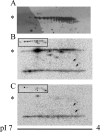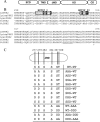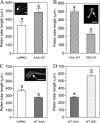Mutations in two putative phosphorylation motifs in the tomato pollen receptor kinase LePRK2 show antagonistic effects on pollen tube length
- PMID: 21131355
- PMCID: PMC3039375
- DOI: 10.1074/jbc.M110.147512
Mutations in two putative phosphorylation motifs in the tomato pollen receptor kinase LePRK2 show antagonistic effects on pollen tube length
Abstract
The tip-growing pollen tube is a useful model for studying polarized cell growth in plants. We previously characterized LePRK2, a pollen-specific receptor-like kinase from tomato (1). Here, we showed that LePRK2 is present as multiple phosphorylated isoforms in mature pollen membranes. Using comparative sequence analysis and phosphorylation site prediction programs, we identified two putative phosphorylation motifs in the cytoplasmic juxtamembrane (JM) domain. Site-directed mutagenesis in these motifs, followed by transient overexpression in tobacco pollen, showed that both motifs have opposite effects in regulating pollen tube length. Relative to LePRK2-eGFP pollen tubes, alanine substitutions in residues of motif I, Ser(277)/Ser(279)/Ser(282), resulted in longer pollen tubes, but alanine substitutions in motif II, Ser(304)/Ser(307)/Thr(308), resulted in shorter tubes. In contrast, phosphomimicking aspartic substitutions at these residues gave reciprocal results, that is, shorter tubes with mutations in motif I and longer tubes with mutations in motif II. We conclude that the length of pollen tubes can be negatively and positively regulated by phosphorylation of residues in motif I and II respectively. We also showed that LePRK2-eGFP significantly decreased pollen tube length and increased pollen tube tip width, relative to eGFP tubes. The kinase activity of LePRK2 was relevant for this phenotype because tubes that expressed a mutation in a lysine essential for kinase activity showed the same length and width as the eGFP control. Taken together, these results suggest that LePRK2 may have a central role in pollen tube growth through regulation of its own phosphorylation status.
Figures







Similar articles
-
Pollen tube localization implies a role in pollen-pistil interactions for the tomato receptor-like protein kinases LePRK1 and LePRK2.Plant Cell. 1998 Mar;10(3):319-30. doi: 10.1105/tpc.10.3.319. Plant Cell. 1998. PMID: 9501107 Free PMC article.
-
STIL, a peculiar molecule from styles, specifically dephosphorylates the pollen receptor kinase LePRK2 and stimulates pollen tube growth in vitro.BMC Plant Biol. 2010 Feb 22;10:33. doi: 10.1186/1471-2229-10-33. BMC Plant Biol. 2010. PMID: 20175921 Free PMC article.
-
Kinase Partner Protein Plays a Key Role in Controlling the Speed and Shape of Pollen Tube Growth in Tomato.Plant Physiol. 2020 Dec;184(4):1853-1869. doi: 10.1104/pp.20.01081. Epub 2020 Oct 5. Plant Physiol. 2020. PMID: 33020251 Free PMC article.
-
The regulation of vesicle trafficking by small GTPases and phospholipids during pollen tube growth.Sex Plant Reprod. 2010 Jun;23(2):87-93. doi: 10.1007/s00497-009-0118-z. Epub 2009 Nov 7. Sex Plant Reprod. 2010. PMID: 20490965 Review.
-
Signaling with Ions: The Keystone for Apical Cell Growth and Morphogenesis in Pollen Tubes.Plant Physiol. 2017 Jan;173(1):91-111. doi: 10.1104/pp.16.01561. Epub 2016 Nov 28. Plant Physiol. 2017. PMID: 27895207 Free PMC article. Review.
Cited by
-
Overexpression of the tomato pollen receptor kinase LePRK1 rewires pollen tube growth to a blebbing mode.Plant Cell. 2014 Sep;26(9):3538-55. doi: 10.1105/tpc.114.127381. Epub 2014 Sep 5. Plant Cell. 2014. PMID: 25194029 Free PMC article.
-
Integrating transcriptome and metabolome analyses to characterize flower development in Salix variegata franch., a typical dioecious plant.Sci Rep. 2025 Mar 7;15(1):8010. doi: 10.1038/s41598-025-91317-0. Sci Rep. 2025. PMID: 40055394 Free PMC article.
-
Receptor-like kinases as surface regulators for RAC/ROP-mediated pollen tube growth and interaction with the pistil.AoB Plants. 2011;2011:plr017. doi: 10.1093/aobpla/plr017. Epub 2011 Aug 19. AoB Plants. 2011. PMID: 22476487 Free PMC article.
-
The juxtamembrane and carboxy-terminal domains of Arabidopsis PRK2 are critical for ROP-induced growth in pollen tubes.J Exp Bot. 2013 Dec;64(18):5599-610. doi: 10.1093/jxb/ert323. Epub 2013 Oct 17. J Exp Bot. 2013. PMID: 24136420 Free PMC article.
-
ZmSTK1 and ZmSTK2, encoding receptor-like cytoplasmic kinase, are involved in maize pollen development with additive effect.Plant Biotechnol J. 2018 Aug;16(8):1402-1414. doi: 10.1111/pbi.12880. Epub 2018 Feb 13. Plant Biotechnol J. 2018. PMID: 29327510 Free PMC article.
References
Publication types
MeSH terms
Substances
LinkOut - more resources
Full Text Sources

